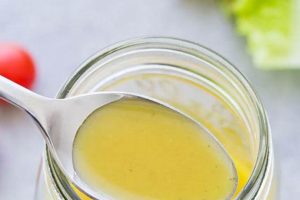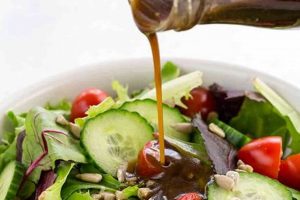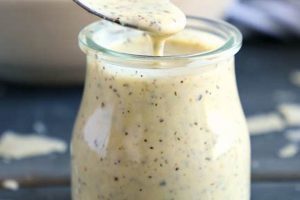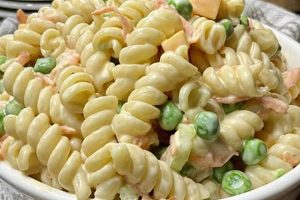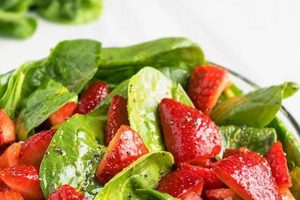A classic emulsion of oil, egg yolk, lemon juice, Worcestershire sauce, garlic, and pungent, salty filets of fish creates the distinctive, savory flavor profile of this iconic dressing. Numerous variations exist, substituting ingredients like Dijon mustard or altering ratios for desired taste and texture. A properly emulsified dressing clings beautifully to crisp romaine lettuce, the traditional base for the namesake salad.
The umami richness imparted by the fish adds depth and complexity, balancing the acidity and creating a flavor experience far beyond simpler dressings. This unique character has solidified its status as a beloved culinary staple, inspiring countless adaptations and remaining a restaurant favorite for generations. Its historical origins are shrouded in some mystery, but the enduring popularity speaks to its powerful appeal.
This article will explore diverse approaches to crafting this dressing, examining traditional methods alongside modern interpretations. Ingredient selection, emulsification techniques, and complementary salad pairings will be discussed to provide a comprehensive understanding of this celebrated condiment.
Tips for Crafting Exceptional Caesar Dressing
Achieving a perfectly balanced and flavorful Caesar dressing requires attention to detail and an understanding of the interplay of ingredients. The following tips offer guidance for elevating this culinary classic.
Tip 1: Embrace High-Quality Anchovies: Opt for oil-packed anchovy fillets, preferably salt-cured. Their rich, umami flavor forms the backbone of the dressing. Rinse the fillets before use to remove excess salt.
Tip 2: Emulsify with Patience: A slow, steady whisk or a food processor ensures a stable emulsion, preventing separation and delivering a creamy texture. Gradually drizzle the oil into the other ingredients while whisking constantly.
Tip 3: Fresh Garlic, Judiciously Used: Freshly minced or grated garlic provides the best flavor. However, too much can overpower the dressing. Start with a small amount and adjust according to preference.
Tip 4: Lemon Juice: The Acidic Foundation: Freshly squeezed lemon juice provides brightness and balances the richness of the other ingredients. Avoid bottled lemon juice, as it often contains additives that can compromise the flavor.
Tip 5: The Role of Egg Yolk: Raw or coddled egg yolks contribute to the emulsification and richness. If using raw yolks, ensure they are fresh and from a reputable source. Pasteurized egg yolks are a safe alternative.
Tip 6: Seasoning with Precision: Kosher salt and freshly ground black pepper enhance the overall flavor profile. Taste and adjust seasonings throughout the preparation process.
Tip 7: Worcestershire Sauce: A Depth Enhancer: Worcestershire sauce adds a complex, savory note. A few dashes are usually sufficient, but experimentation is encouraged.
By adhering to these guidelines, one can consistently produce a Caesar dressing that rivals those found in the finest restaurants. Mastery of these techniques allows for personalized variations, catering to individual preferences and culinary creativity.
Equipped with these insights, exploration of specific recipe variations and advanced techniques can further refine one’s Caesar dressing expertise.
1. High-quality Anchovies
The foundation of an authentic Caesar salad dressing rests upon the nuanced flavor profile of high-quality anchovies. These small, oily fish, often misunderstood, provide a depth of umami richness essential to the dressing’s character. Selecting and utilizing the right anchovies significantly impacts the final product.
- Salt-Cured vs. Oil-Packed:
Salt-cured anchovies offer a more intense, concentrated flavor but require rinsing and filleting before use. Oil-packed anchovies are more convenient, readily available, and milder in flavor. While both types can contribute to a delicious dressing, oil-packed fillets are generally preferred for ease of use.
- Origin and Processing:
Anchovies from different regions exhibit subtle variations in flavor. European anchovies, particularly those from Spain or Italy, are often favored for their delicate balance of saltiness and umami. The method of processing, whether traditional hand-filleting or modern techniques, also influences the final product’s quality and flavor consistency.
- Visual Indicators of Quality:
High-quality anchovies typically exhibit a firm texture and a deep, reddish-brown color. Avoid those with a dull appearance or overly fishy odor. The fillets should be intact and packed neatly, indicating careful handling and processing.
- Impact on Flavor Profile:
The quality of the anchovies directly correlates with the dressing’s overall taste. Inferior anchovies can impart an unpleasant fishy or overly salty taste, whereas premium anchovies contribute a subtle, savory depth that enhances the other ingredients without dominating the flavor profile. This nuanced umami character is the hallmark of a truly exceptional Caesar dressing.
Ultimately, the selection of high-quality anchovies represents a commitment to crafting a Caesar dressing that embodies authenticity and culinary excellence. The subtle nuances of flavor and texture contributed by these small but mighty fish elevate the dressing from ordinary to extraordinary.
2. Proper Emulsification
Proper emulsification is crucial for a successful Caesar salad dressing. This process integrates the oil and water-based ingredients (lemon juice, vinegar) into a stable, creamy mixture that clings to the lettuce and delivers a balanced flavor experience. Without proper emulsification, the dressing separates, resulting in an oily layer on top and a thin, watery base. This not only compromises the texture and appearance but also diminishes the overall enjoyment of the salad. The anchovies, while providing crucial flavor, also contribute oil, making emulsification even more vital. Their flavorful oil must be seamlessly incorporated into the dressing’s emulsion.
The emulsification process utilizes the lecithin found in egg yolks. Lecithin acts as a binding agent, allowing the oil and water molecules to disperse evenly and remain stable. A slow, gradual addition of oil to the other ingredients, combined with continuous whisking or blending, encourages the formation of small oil droplets coated in lecithin, preventing them from coalescing and separating. This creates a smooth, homogenous dressing that adheres uniformly to the lettuce leaves. Failure to emulsify properly results in a broken dressing, where the oil and water-based components separate, detracting from the desired creamy texture and consistent flavor delivery.
Achieving a stable emulsion is a hallmark of a well-made Caesar dressing. It showcases attention to detail and understanding of fundamental culinary techniques. The smooth, creamy texture contributes to the overall sensory experience, allowing the complex flavors of the anchovies, garlic, and lemon juice to coat the palate evenly. A properly emulsified dressing also enhances the presentation of the salad, ensuring an appealing and appetizing appearance. Challenges in emulsification can often be remedied by adding a small amount of additional egg yolk or restarting the process with a clean bowl and whisk. Understanding the science behind emulsion contributes significantly to consistently producing a high-quality Caesar salad dressing.
3. Fresh Ingredients
The quality of a Caesar salad dressing hinges directly on the freshness of its components. This classic dressing relies on a delicate balance of flavors, easily compromised by stale or low-quality ingredients. Fresh garlic, vibrant lemon juice, and properly stored anchovies contribute significantly to the overall taste and aroma. Using fresh garlic, rather than pre-minced or powdered versions, delivers a pungent, aromatic bite that complements the other ingredients without overpowering them. Similarly, freshly squeezed lemon juice provides a bright acidity that balances the richness of the anchovies and egg yolk. Bottled lemon juice often contains preservatives and additives that can negatively impact the flavor profile. High-quality anchovy fillets, stored correctly in oil and refrigerated, provide a deep umami flavor. Their quality degrades over time or with improper storage, leading to a less desirable fishy taste.
Consider the difference between a dressing made with freshly squeezed lemon juice versus bottled juice. The fresh juice offers a vibrant, clean acidity, while the bottled version may present a duller, slightly metallic taste. Similarly, the pungent aroma of freshly grated garlic contrasts sharply with the muted, almost stale scent of pre-minced garlic. These seemingly small differences significantly impact the final product. A Caesar salad dressing prepared with fresh, high-quality ingredients elevates the dish, delivering a more nuanced and enjoyable sensory experience. Conversely, using subpar ingredients compromises the dressing’s integrity, resulting in a less vibrant and flavorful outcome.
The emphasis on fresh ingredients underscores the importance of prioritizing quality in crafting a truly exceptional Caesar salad dressing. While convenience may tempt some to opt for pre-prepared or processed ingredients, the resulting compromise in flavor and aroma is undeniable. By prioritizing fresh, high-quality components, one ensures a final product that embodies the true essence of this classic dressing. This commitment to freshness transforms a simple salad into a culinary delight, demonstrating a dedication to both flavor and quality. The effort invested in sourcing and utilizing the freshest ingredients pays dividends in the final product’s taste and overall enjoyment.
4. Balanced Seasoning
Balanced seasoning is paramount in a Caesar salad dressing featuring anchovies. The inherent saltiness of anchovies necessitates a careful approach to additional sodium. Over-salting easily obscures the nuanced flavors of the garlic, lemon juice, and other components. Conversely, insufficient seasoning results in a bland dressing that fails to complement the crisp romaine lettuce. Achieving a harmonious balance allows the umami richness of the anchovies to shine through while supporting the other flavors. This balance is achieved through iterative tasting and adjustment during preparation. Kosher salt, due to its larger crystal size and clean flavor, is often preferred. Freshly ground black pepper adds a subtle layer of complexity and spice. The interaction of salt and pepper with the other ingredients creates a dynamic flavor profile.
Consider a scenario where the dressing is overly salty. The intense saltiness masks the subtle nuances of the other ingredients, rendering the anchovies’ umami contribution one-dimensional and overwhelming. The bright acidity of the lemon juice becomes muted, and the delicate aroma of the garlic is lost. On the other hand, a dressing lacking sufficient salt fails to engage the palate. The flavors fall flat, and the overall experience becomes underwhelming. The anchovies’ umami, instead of adding depth, contributes a vague fishiness. A real-life example can be found in comparing commercially produced Caesar dressings. Many mass-produced varieties suffer from either excessive saltiness or a lack of seasoning, demonstrating the crucial role of balanced seasoning in achieving a high-quality product.
Mastery of balanced seasoning elevates the Caesar salad dressing from simply functional to genuinely enjoyable. It allows the inherent qualities of each ingredient to contribute to a cohesive and harmonious whole. The practical significance of this understanding lies in the ability to consistently produce a dressing that complements, rather than overwhelms, the other components of the salad. This precise calibration of flavors enhances the overall dining experience, transforming a simple salad into a culinary masterpiece. The careful interplay of salt and pepper with the other ingredients underscores the importance of precision and attention to detail in crafting a truly exceptional Caesar salad dressing.
5. Authentic Techniques
Authentic techniques are integral to crafting a Caesar salad dressing that truly captures the essence of this culinary classic, particularly when anchovies play a starring role. These techniques, often passed down through generations, influence not only the final flavor profile but also the texture and overall quality of the dressing. A key example lies in the method of emulsifying the dressing. Traditional approaches emphasize a slow, gradual addition of oil to the egg yolk and other ingredients while whisking constantly. This deliberate process encourages the formation of a stable emulsion, resulting in a creamy, cohesive dressing that clings beautifully to the romaine lettuce. Modern shortcuts, such as using a blender or food processor, may expedite the process, but often compromise the delicate balance and texture achieved through traditional hand-emulsification. The subtle differences in texture and flavor become readily apparent when comparing a hand-whisked dressing to one made with a machine. The hand-whisked version typically exhibits a lighter, more aerated texture and a more nuanced flavor profile. Furthermore, authentic techniques often call for specific ingredients, such as high-quality anchovy fillets packed in oil, and emphasize the importance of fresh ingredients like garlic and lemon juice. These choices, while seemingly minor, contribute significantly to the dressing’s overall authenticity and depth of flavor.
The practical significance of employing authentic techniques becomes evident in the final product. A Caesar salad dressing made with these time-honored methods possesses a distinct character. The emulsion is stable and creamy, the flavors are balanced and nuanced, and the overall experience is elevated. Consider the difference between a dressing made with fresh garlic, painstakingly minced, versus one made with pre-minced garlic from a jar. The fresh garlic delivers a bright, pungent aroma and flavor that complements the anchovies and other ingredients. The pre-minced garlic, on the other hand, often imparts a duller, less vibrant taste. This seemingly small detail underscores the impact of authentic techniques on the final product. Another illustrative example lies in the use of coddled egg yolks in some traditional recipes. This method, while more time-consuming than using raw yolks, yields a richer, more velvety texture and mitigates concerns about consuming raw eggs. These examples demonstrate the tangible benefits of adhering to authentic practices.
In conclusion, authentic techniques represent more than just adherence to tradition. They embody a deep understanding of the principles underlying a classic Caesar salad dressing. These methods, honed over time, ensure a superior outcome in terms of flavor, texture, and overall quality. While modern shortcuts may offer convenience, they often compromise the nuanced flavors and textures achieved through traditional methods. Embracing authentic techniques, particularly when incorporating the rich umami of anchovies, ensures a Caesar salad dressing that honors the dish’s origins and delivers a truly exceptional culinary experience. The challenges of mastering these techniques are ultimately rewarded with a dressing that stands apart in its depth of flavor and textural complexity.
Frequently Asked Questions
This section addresses common inquiries regarding the preparation and nuances of Caesar salad dressing incorporating anchovies.
Question 1: What is the primary role of anchovies in Caesar salad dressing?
Anchovies contribute a crucial umami element, adding depth and complexity to the dressing. Their savory notes balance the acidity of the lemon juice and create a richer flavor profile.
Question 2: Can Caesar salad dressing be made without anchovies?
While variations exist, omitting anchovies fundamentally alters the dressing’s authentic character. Substitutions, such as Worcestershire sauce or other umami-rich ingredients, can offer a semblance of the savory depth, but the true essence of a classic Caesar dressing relies on the presence of anchovies.
Question 3: How can one mitigate the intense saltiness of anchovies in the dressing?
Rinsing the anchovy fillets under cold water before incorporating them into the dressing helps reduce excess salt. Careful monitoring of additional salt during preparation is also crucial. Tasting and adjusting seasoning iteratively ensures a balanced flavor profile.
Question 4: What are suitable alternatives for raw egg yolks in Caesar dressing?
Pasteurized egg yolks provide a safe alternative to raw yolks while maintaining the emulsification properties necessary for a creamy texture. Coddled egg yolks, gently heated to a specific temperature, offer another option, contributing a richer flavor and mitigating safety concerns associated with raw eggs.
Question 5: How should Caesar salad dressing be stored?
Refrigeration in an airtight container is essential for preserving the dressing’s freshness and preventing bacterial growth. Ideally, consume the dressing within a few days of preparation for optimal flavor and quality. Emulsification may break down slightly upon refrigeration, but gentle whisking typically restores the desired texture.
Question 6: Why is proper emulsification crucial for Caesar dressing?
Emulsification creates a stable mixture of oil and water-based ingredients, preventing separation and ensuring a smooth, creamy texture. This process, facilitated by the lecithin in egg yolks, allows the dressing to cling evenly to the lettuce, delivering a balanced flavor experience in each bite. A broken emulsion results in an oily, unappetizing dressing.
Understanding these key aspects of Caesar salad dressing preparation ensures a consistently delicious and authentic culinary experience. Attention to detail, from ingredient selection to proper emulsification, significantly impacts the final result.
The following section will explore variations on the classic Caesar salad dressing, demonstrating the versatility of this iconic condiment.
Caesar Salad Dressing Recipe with Anchovies
Exploration of this classic dressing reveals the importance of high-quality ingredients, precise techniques, and an understanding of the delicate balance of flavors. From the essential umami contribution of anchovies to the crucial role of proper emulsification, each element contributes to the final product’s success. Fresh ingredients, balanced seasoning, and adherence to authentic techniques further enhance the dressing’s quality and ensure an authentic culinary experience. Addressing common questions regarding ingredient selection, preparation methods, and storage provides a comprehensive understanding of this iconic condiment.
Caesar salad dressing, with its rich history and enduring popularity, continues to inspire culinary creativity. A deeper appreciation of its core components and the techniques that elevate its preparation allows for continued exploration and enjoyment of this timeless classic. The pursuit of culinary excellence encourages further experimentation and refinement of this iconic dressing, ensuring its place in gastronomy for generations to come.


